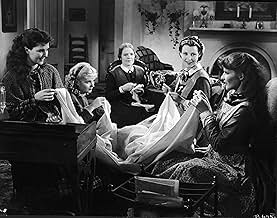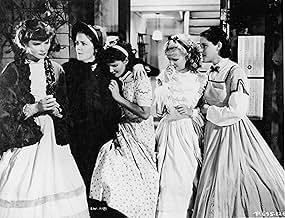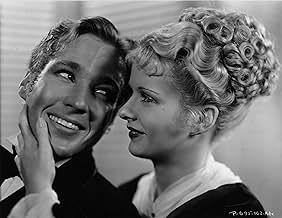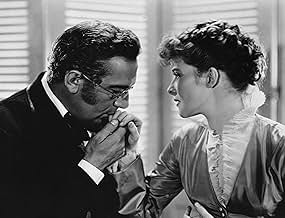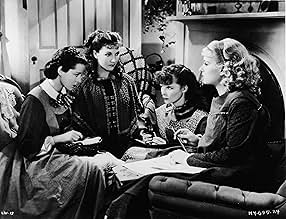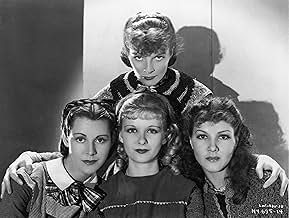IMDb-BEWERTUNG
7,1/10
8339
IHRE BEWERTUNG
Füge eine Handlung in deiner Sprache hinzuA chronicle of the lives of sisters growing up in 19th-century New England.A chronicle of the lives of sisters growing up in 19th-century New England.A chronicle of the lives of sisters growing up in 19th-century New England.
- 1 Oscar gewonnen
- 7 Gewinne & 4 Nominierungen insgesamt
John Lodge
- Brooke
- (as John Davis Lodge)
Samuel S. Hinds
- Mr. March
- (as Samuel Hinds)
Nina Borget
- Housekeeper
- (Nicht genannt)
Francesca Braggiotti
- Dance Teacher
- (Nicht genannt)
Luke Cosgrave
- Old Man
- (Nicht genannt)
Empfohlene Bewertungen
Little Women (1933)
A fairly lavish affair, with one of my favorite directors, George Cukor, making the most of his growing fame as a "woman's director." Of course, the leads here are four girls and their mother, among the children the rising star, Katherine Hepburn, in her second film (after Bill of Divorcement, also by Cukor, and a better film in many ways).
The standards here are high, the acting solid, the sets uncompromised. The plot is very goody-goody, for lack of a better word. There is a lot of family sweetness, growing young love affairs, charity to the poor, and a feeling of life being simply terrific, whatever its worries (worries like the Civil War, raging quietly in the background, never seen and rarely felt).
Cukor makes the most of Alcott's novel, I think, and Hepburn is wonderful, with all the hints of her real greatness on screen to come. The basic structure of the plot (or plots) is how each girl matures, overcoming personality flaws to become truly admirable people. It might be frustrating that human flaws are simply to be overcome, but we shouldn't resent a little optimism, and reaching higher goals, now and then. A heartfelt and really well made American drama. And I admit freely, I cried several times. That's better than any words.
A fairly lavish affair, with one of my favorite directors, George Cukor, making the most of his growing fame as a "woman's director." Of course, the leads here are four girls and their mother, among the children the rising star, Katherine Hepburn, in her second film (after Bill of Divorcement, also by Cukor, and a better film in many ways).
The standards here are high, the acting solid, the sets uncompromised. The plot is very goody-goody, for lack of a better word. There is a lot of family sweetness, growing young love affairs, charity to the poor, and a feeling of life being simply terrific, whatever its worries (worries like the Civil War, raging quietly in the background, never seen and rarely felt).
Cukor makes the most of Alcott's novel, I think, and Hepburn is wonderful, with all the hints of her real greatness on screen to come. The basic structure of the plot (or plots) is how each girl matures, overcoming personality flaws to become truly admirable people. It might be frustrating that human flaws are simply to be overcome, but we shouldn't resent a little optimism, and reaching higher goals, now and then. A heartfelt and really well made American drama. And I admit freely, I cried several times. That's better than any words.
I will always have a soft spot for this film, and to me it is the best version of the three versions I've seen so far of Little Women(1994 and 1949 were the others, and I liked both of them very much). The sound here is a little too tinny, and the Laurie of Douglass Montgommery is too fey for my tastes. However, it still looks beautiful, the costumes and hairstyles are well suited to the period, the sets are sumptuous and the film is very handsomely shot. There is also a stirring score from Max Steiner, making it sound appropriately nostalgic, the script is faithful and warm-toned, it is directed with great taste by George Cukor and the story has all the warmth and poignancy of the book, which is one of my favourites of all time. Apart from Montgommery I loved the acting, Edna May Oliver here does what she did best, more than convincingly play sharp-tongued spinsters, and Henry Stephenson is a dear Mr Laurence. Paul Lukas is an unexceptional but romantic Professor Bhaer, an improvement on the wooden and too-Italianate Rosanno Brazzi in the 1949 film, and Spring Byington a Marmee of real sincerity. The four March girls Meg, Jo, Beth and Amy(aka the Little Women of the title) are what drive the story, and all four really shone here. Joan Bennett is appealing as Amy and leaves room for character growth from a vain little girl to an elegant young lady. Jean Parker is a very sweet and moving Beth, and Frances Dee is beautiful as Meg should be. Best of all is the Jo of Katharine Hepburn, who is perfectly cast in a role she was born to play. All in all, truly lovely and the best version to me. 9/10 Bethany Cox
This satisfying movie adaptation of "Little Women" features a strong cast and a production that was quite solid for 1933. While a glance at the story outline might give the impression that it is simplistic or childlike, that is far from the case. The novel offers well-defined characters and many situations that bring out worthwhile insights into the characters and into life in general. While neither this nor the other movie versions of the story have the same thematic depth, this version effectively presents enough of the material in a thoughtful and entertaining way.
Katherine Hepburn heads the cast, and gives plenty of life to Jo. Naturally she gets the main focus, but the other sisters and the secondary characters also get some good moments, and most of them get a chance to steal a scene or two. Henry Stephenson and Douglas Montgomery get a number of good scenes as the March family's neighbors. Edna May Oliver is well cast, and it's only too bad that she did not get a couple more scenes. Paul Lukas makes Professor Baer come alive. By no means least are Jean Parker, Frances Dee, and Joan Bennett as Beth, Meg, and Amy.
It is often easy to tell when the movie was made, most especially because of the sound. But actually the production is better technically and artistically than are most movies of the early 1930s. Several of the sets are particularly well done, creating just the right atmosphere for their scenes. Director George Cukor puts it all together nicely.
This is the kind of movie that is generally out of style at present, because it lacks the kind of self-indulgent material and the self-absorbed style that so unduly impress many of today's movie fans. But the only genuine weakness is that it has a few technical limitations, most of which are common to many films of its era.
What this adaptation does offer is a sympathetic and sometimes insightful look at the lives of some ordinary but strong persons, who are brought to life by a good cast and a director who seemed himself to care about the characters.
Katherine Hepburn heads the cast, and gives plenty of life to Jo. Naturally she gets the main focus, but the other sisters and the secondary characters also get some good moments, and most of them get a chance to steal a scene or two. Henry Stephenson and Douglas Montgomery get a number of good scenes as the March family's neighbors. Edna May Oliver is well cast, and it's only too bad that she did not get a couple more scenes. Paul Lukas makes Professor Baer come alive. By no means least are Jean Parker, Frances Dee, and Joan Bennett as Beth, Meg, and Amy.
It is often easy to tell when the movie was made, most especially because of the sound. But actually the production is better technically and artistically than are most movies of the early 1930s. Several of the sets are particularly well done, creating just the right atmosphere for their scenes. Director George Cukor puts it all together nicely.
This is the kind of movie that is generally out of style at present, because it lacks the kind of self-indulgent material and the self-absorbed style that so unduly impress many of today's movie fans. But the only genuine weakness is that it has a few technical limitations, most of which are common to many films of its era.
What this adaptation does offer is a sympathetic and sometimes insightful look at the lives of some ordinary but strong persons, who are brought to life by a good cast and a director who seemed himself to care about the characters.
From the opening titles displaying a snow covered Curier and Ives - like print underscored by a melody played on a tinkling spinet, this 1933 version of Louisa Alcott's beloved novel holds one in thrall. A Civil War era tale of a New England family's joys and tribulations centers on the March household : mother "Marmee" and her four daughters; Meg, Amy, Beth and Jo. The screenplay centers on each girl's commitment to "showing her father proud", father being a minister gone of f to war to meet the spiritual needs of the Yankee soldiers. Buoyed by their mother [ the ever perfect Spring Byington ] the girls learn the meaning of giving and sacrifice with a jollity that may be off-putting to 21st century viewers; but stick with it, for what this picture offers is nothing less than real life at its most joyful and painful. After a series of seemingly inconsequential events, the girls' placid lives are disrupted when a sibling takes ill. This section of the movie is riveting, due to the superb direction of George Cukor and Katherine Hepburn as the tomboyish Jo. The scene where Jo retreats to the attic, worried sick over the fate of her ill sister, is gut wrenching. Hepburn was just hitting her stride as a movie actress when this film came out. Not the typical glamour girl of the time, her odd beauty and diction translated into a strange alchemy when projected on a movie screen : she is unforgettable. The other actresses acquit themselves beautifully but the picture belongs to Hepburn. Lest you think all is dour and dull, this movie offers so much that is truly entertaining : a heartwarming homecoming scene; the March girls presenting a "play" in their living room to the consternation and delight of invited neighbors and several moments involving a cantankerous but lovable aunt [ the ubiquitous Edna May Oliver ]. The movie is properly accoutered with lovely interiors and authentic production design and costumes [ gabled houses and ivy covered porches; hoop skirts and muffs ]. The entire production is like a gift wrapped edition of the novel turned to celluloid! The icing on the cake, so to speak, is Max Steiner's spare, evocative music score, employing Beth's piano playing for family get togethers, parties etc., and orchestral "commentary" for dramatic, comic and action sequences. Only six years had passed since sound recording had revolutionized the film industry, but this "early talkie" uses the new technology very adeptly; although camera movement is minimal, the editing is very fluid. The sound, courtesy of old Western Electric, is fine, especially on the recent DVD release, where both aural and visual elements have been restored, assuring a great presentation. When a movie has the power to reach out over a span of seven decades and touch jaded hearts in another century, that is a sign of a classic. LITTLE WOMEN is a great American film.
In fanfiction there is the phenomenon called the "Mary Sue"--a character who is an (idealized) version of the author who is inserted into the story to act out the author's fantasy. The original Mary Sue was in a Star Trek fanfiction where Ensign Mary Sue was braver than Kirk, smarter than Spock, more compassionate than McCoy, etc. who is able to save the day when nobody else can.
What has this, I hear you ask, to do with 'Little Women'? I think that all the March girls, but especially Jo, are somewhat Mary Sues to Louisa May Alcott. They are just too perfect. Especially Beth. Oscar Wilde said of Dickens' Little Nell that it would take a heart of stone not to laugh out loud reading her death scene; the same remark could apply to Beth. And Marmee is just to saintly and patient to be believed.
Still, in spite of it all, the film was worth watching, especially to see the young Kate Hepburn. I especially appreciate the time when she was asked when she would grow up and act like a proper lady, and she replied, "Never! Even when I'm old and walk with a cane!" (Or something to that effect.) Highly prophetic, as that was exactly how Kate lived.
What has this, I hear you ask, to do with 'Little Women'? I think that all the March girls, but especially Jo, are somewhat Mary Sues to Louisa May Alcott. They are just too perfect. Especially Beth. Oscar Wilde said of Dickens' Little Nell that it would take a heart of stone not to laugh out loud reading her death scene; the same remark could apply to Beth. And Marmee is just to saintly and patient to be believed.
Still, in spite of it all, the film was worth watching, especially to see the young Kate Hepburn. I especially appreciate the time when she was asked when she would grow up and act like a proper lady, and she replied, "Never! Even when I'm old and walk with a cane!" (Or something to that effect.) Highly prophetic, as that was exactly how Kate lived.
Wusstest du schon
- WissenswertesKatharine Hepburn asked costume designer Walter Plunkett to copy a dress her maternal grandmother wore in a tintype photograph.
- PatzerIn the Christmas play when the prop tower falls down, Jo's lips aren't moving when she says "Everything is all right."
- Zitate
Beth March: You're old enough now to leave off boyish tricks and behave better, Josephine. Now you are so tall and turn up your hair, you must remember you're a young lady.
Jo March: No, l'm not. And if turning up my hair makes me so, l'll wear it down till l'm a hundred!
- Crazy CreditsPaul Lukas as Professor Bher is not listed in the closing credits.
- Alternative VersionenOlder video and television prints remove the original RKO logo in the opening and replace it with the one from Selznick International.
- VerbindungenFeatured in David O. Selznick: 'Your New Producer' (1935)
- SoundtracksThe Girl I Left Behind Me
(uncredited)
Traditional
Played during the opening scene
Top-Auswahl
Melde dich zum Bewerten an und greife auf die Watchlist für personalisierte Empfehlungen zu.
Details
- Erscheinungsdatum
- Herkunftsland
- Sprachen
- Auch bekannt als
- Las cuatro hermanitas
- Drehorte
- Providencia Ranch, Hollywood Hills, Los Angeles, Kalifornien, USA(exterior of March house)
- Produktionsfirma
- Weitere beteiligte Unternehmen bei IMDbPro anzeigen
Box Office
- Budget
- 424.000 $ (geschätzt)
- Laufzeit
- 1 Std. 55 Min.(115 min)
- Seitenverhältnis
- 1.37 : 1
Zu dieser Seite beitragen
Bearbeitung vorschlagen oder fehlenden Inhalt hinzufügen


